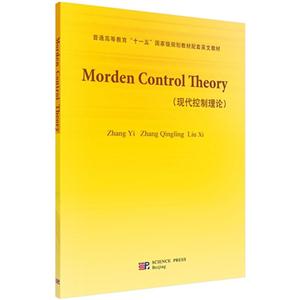-
>
中医基础理论
-
>
高校军事课教程
-
>
思想道德与法治(2021年版)
-
>
毛泽东思想和中国特色社会主义理论体系概论(2021年版)
-
>
中医内科学·全国中医药行业高等教育“十四五”规划教材
-
>
中医诊断学--新世纪第五版
-
>
中药学·全国中医药行业高等教育“十四五”规划教材
现代控制理论 版权信息
- ISBN:9787030412522
- 条形码:9787030412522 ; 978-7-03-041252-2
- 装帧:一般胶版纸
- 册数:暂无
- 重量:暂无
- 所属分类:>>
现代控制理论 本书特色
建立在状态空间法基础上的一种控制理论,是自动控制理论的一个主要组成部分。在现代控制理论中,对控制系统的分析和设计主要是通过对系统的状态变量的描述来进行的,基本的方法是时间域方法。现代控制理论比经典控制理论所能处理的控制问题要广泛得多,包括线性系统和非线性系统,定常系统和时变系统,单变量系统和多变量系统。它所采用的方法和算法也更适合于在数字计算机上进行。现代控制理论还为设计和构造具有指定的性能指标的*优控制系统提供了可能性。 这本由zhang yi、zhang qingling、liu xi编写的《现代控制理论(普通高等教育十一五国家级规划教材配套英文教材)》是关于介绍“现代控制理论 ”的英文版教材。
现代控制理论 内容简介
学习专业英语是数学专业本科生的必修课程。如果使用纯英文教材,学生接受起来比较困难。如果是纯粹的中文教学方式又不能与国际化现代教学的实际需要接轨。因此,本教材与现在使用的中文教材《控制理论基础》相配合,便于理科学生通过双语教学获得控制理论知识的同时,掌握必要的专业英语阅读能力。为配合本科双语教学的需要。其优点有二:其一,国外出版的英文教材《控制理论基础》难度较大,内容较深,不符合我校本科教学的需要,学生不容易接受和理解;其二,此次申报教材与正在使用的《控制理论基础》相配套呼应,也由张庆灵主编,和现在使用的中文教材内容基本相对照,能够加强数学系本科生的阅读英文文献的能力,为今后的科研工作打下良好的基础。全书内容主要包括:线性系统的数学描述、状态转移矩阵、线性系统的运动分析、线性系统的能控性和能观性、Matlab实现、系统运动的稳定性、状态反馈和输出反馈、观测器设计和*优控制原理等。
现代控制理论 目录
chapter 0 backgrounds
0.1 development of control theory
0.2 main contents of modern control theory
chapter 1 mathematical description of systems
1.1 example
1.2 basic definitions
1.3 system descriptions
1.4 finding state equations from high-differential operator representation
1.4.1 controllable canonical form
1.4.2 observable canonical form
1.4.3 other special form
1.5 block diagram
1.6 transfer function from state space representation
1.6.1 definition
1.6.2 calculation for the transfer function matrix
1.7 composite systems
1.7.1 tandem connection
1.7.2 parallel connection
1.7.3 feedback connection
1.8 equivalent transformation
1.8.1 equivalent transformation of the state space description for linear systems
1.8.2 diagonal canonical form and jordan canonical form of the system
1.8.3 invarianee of the system matrix and transfer function matrix
1.9 application of matlab in the representation of linear systems
1.10 exercises
chapter 2 solutions
2.1 state transition matrix
2.2 matrix exponential
2.2.1 definition
2.2.2 properties of the matrix exponential
2.2.3 calculations for the matrix exponential
2.3 solution of linear time-invariant systems
2.4 solution of linear time-varying systems
2.5 linear discrete time-invariant systems
2.5.1 discretization of linear discrete time-invariant systems "
2.5.2 solutions of the linear discrete time-invariant systems
2.6 matlab for linear system motion analysis
2.7 exercises
chapter 3 controllability and observability
3.1 definitions
3.1.1 controllability
3.1.2 observability
3.2 controllability of linear continuous systems
3.2.1 time-invariant systems
3.2.2 time-varying systems
3.2.3 controllability index
3.3 observability of linear continuous systems
3.3.1 time-invariant systems
3.3.2 time-varying systems
3.3.3 observability index
3.4 principle of duality
3.5 controllable and observable canonical forms of siso
3.6 structural decomposition of linear systems
3.6.1 controllability and observability of linear time-invariant systems with nonsingular transformation
3.6.2 controllability decomposition
3.6.3 observable decomposition
3.6.4 canonical decomposition
3.7 matlab application for controllability and observability
3.8 exercises
chapter 4 irreducible realizations
4.1 introduction
4.2 the realization of transfer function matrix of siso control systems..
4.3 the realization of transfer function matrix of mimo control systems
4.4 the minimal realization
4.5 irreducible realization by matlab
4.6 exercises
chapter 5 stability
5.1 definitions
5.2 stability criteria
5.2.1 routh criterion
5.2.2 root locus method
5.2.3 the first method of lyapunov
5.2.4 the second method of lyapunov
5.2.5 krasovsky discriminance
5.2.6 variable gradient method
5.3 application of matlab in stability
5.4 exercises
chapter 6 feedbacks
6.1 definitions
6.1.1 state feedbacks
6.1.2 output feedbacks
6.1.3 derivative feedback
6.2 the effects of controllability and observability by feedback
6.2.1 state feedbacks
6.2.2 output feedbacks
6.3 pole assignment
6..3.1 siso case
6.3.2 mimo case
6.4 stabilization
6.5 decoupling
6.5.1 the statement of decoupling control problem
6.5.2 necessary and sufficient conditions for decoupling systems with the state feedback
6.6 application of matlab in feedback
6.6.1 state feedback and pole assignment by matlab
6.6.2 decoupling by matlab
6.7 exercises
chapter 7 observers
7.1 basic concepts
7.2 dimensional state observers
7.3 reduced-dimensional state observers
7.4 feedback system with state observers
7.5 design state observers by matlab
7.6 exercises
chapter 8 optimal control
8.1 optimal control problems
8.1.1 examples
8.1.2 description of optimal control problems
8.2 the calculus of variations to the optimal control
8.2.1 the basis of yhnctional and variation
8.2.2 the eulerian equation
8.2.3 conditional extremum
8.2.4 the calculus of variation
8.3 linear quadratic regulator problems
8.3.1 the statement of lqr
8.3.2 the finite-time state regulator problems
8.3.3 the infinite-time state-regulator problems
8.3.4 the output-regulator problems
8.3.5 the tracking problems
8.4 the application of matlab in optimal control problems.-
8.5 exercises
bibliography
-
食品添加剂
¥33.5¥45 -
VB语言程序设计
¥29.9¥39.8 -
C语言程序设计习题与实验指导
¥9.1¥18 -
地下建筑结构-(第三版)-(赠课件)
¥49.4¥55 -
模具制图
¥37.8¥49 -
工程机械结构认知
¥10.5¥22






















